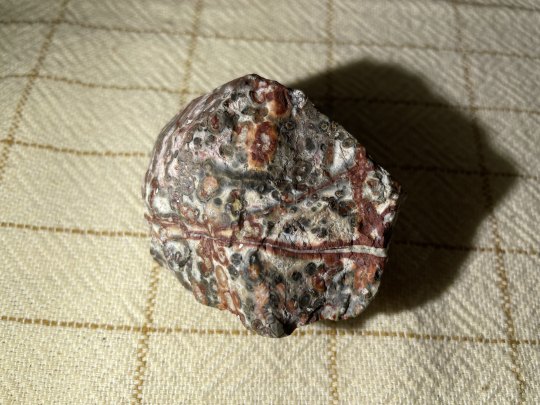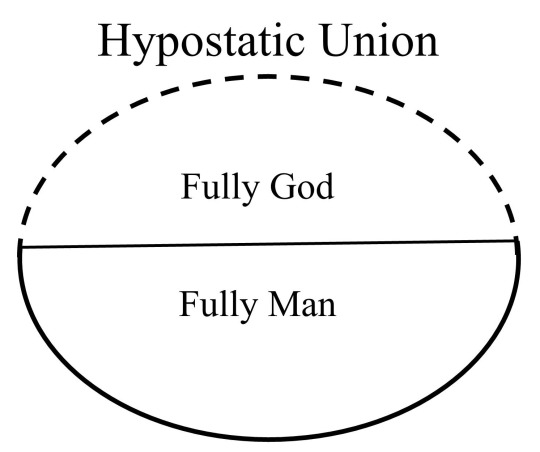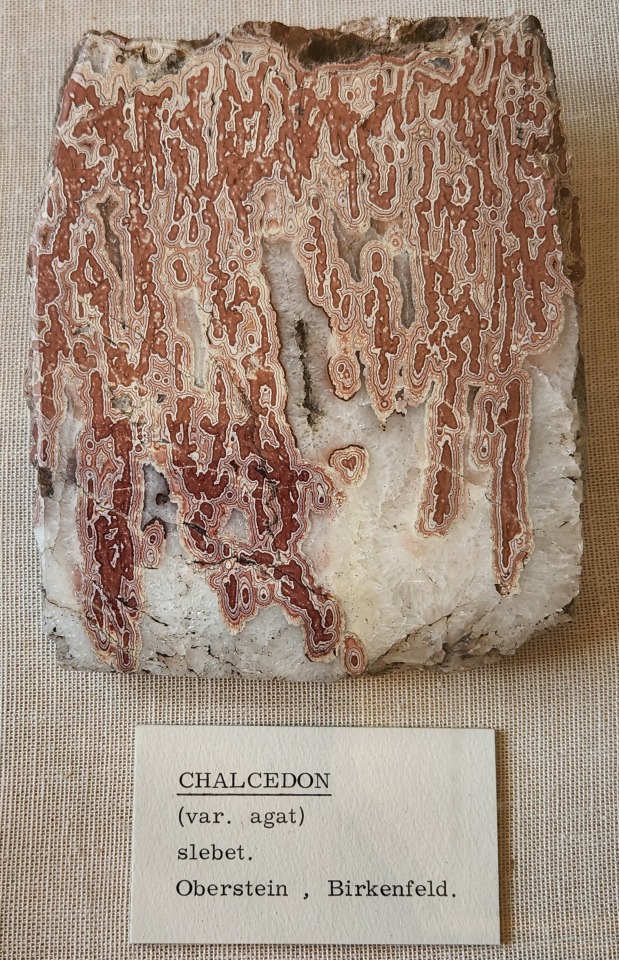#Chalcedon
Photo

Chalcedony
Natural History Museum of Denmark, Mineral Hall
#chalcedon#chalcedony#minerals#geology#natural history museum#natural history#natural history museum of denmark#danish natural history museum#danish museum#danish museums#museum#museums#mineral hall
137 notes
·
View notes
Text
Want to do a group excercise?
I found this rock years ago in the Ambitzgi Riet which you can find on Maps at (47°18'10.5"N 8°48'23.9"E). It is a swampy area dominated by drumlins and anthropogenic interferences such as a railway line, where people go to take a walk and stuff. Back then I went to an alpine petrologist at ETH Zürich to ask their opinion on it, as I myself wasn't quite sure what to make of this rock after trying to determine it on my own.
It does not react with hydrochloric acid, except for on one of the edges (you can probably already see which one). Overall it has rough edges & cuts, except for one area in which it is more eroded & smoothened. Most of it has a matte shine, except for almost all of the fillings in those round sorta dots. Some of those fillings are transparent, some aren't & just white. The dots /balls may be a filling. We didn't do a chemical analasys back then & I didn't go a second time with the same rock.
Back then the answer was it's probably chalcedon and agate /achat. You can find rock like this in Germany or more likely even Mexico, thing is: Not in the swampy area I found it at and not anywhere adjacent to it.
So here's the question: He was probably correct on the composition of the rock, though it may contain more stuff that went unmentioned. If we can assume all of it was correctly stated, what do you believe to be the story behind how it got to where I found it? What would you challenge or check again?



#rock#petrology#agate#achat#chalcedon#switzerland#rock determining#stone#geology#alps#riet#questions
5 notes
·
View notes
Link
#Amethyst#Apatit#Aquamarin#Bergkristall#Blockadenlösen#Calcit#Carneol#Chalcedon#Citrin#Die-Stern-Taler#Falkenauge#Fluorit#Glücksbringer#Glücksstein#Jaspis#Karneol#Kunzit#Labradorit#Larimar#Magnesit#Malachit#Obsidian#Rauchquarz#Rosenquarz#Rutilquarz#Serpentin#SindTrommelsteineEdelsteine?#Sodalith#Sonnenstein#Sternzeichen
0 notes
Photo

Opal różowy i chalcedon niebieski 💗💙 Dziś tak trochę w innym stylu 🙂 Czasem mnie natchnie, żeby coś trochę powywijać 😉 . Ps. Grudnik mi zakwitł i to taki który już miałam "wyśmiecić" 😁 . #byćkobietą #srebro #wisiorek #wisior #naszyję #naszyjnik #biżuteriadlakobiet #biżuteriasrebrna #biżuteriaartystyczna #opal #opalróżowy #chalcedon #grudnik #kwiatekdoniczkowy #kwitniemy #ooakjewelry #innabiżuteria #etsylove #etsyjewelry #etsyshop #etsy #dziewczynykfs #instawtorek #galeriabiżuterii #galeria_rekodziela #rekodzielonacodzien #rękodzieło_pl #bohobiżuteria https://www.instagram.com/p/Ck25r4comef/?igshid=NGJjMDIxMWI=
#byćkobietą#srebro#wisiorek#wisior#naszyję#naszyjnik#biżuteriadlakobiet#biżuteriasrebrna#biżuteriaartystyczna#opal#opalróżowy#chalcedon#grudnik#kwiatekdoniczkowy#kwitniemy#ooakjewelry#innabiżuteria#etsylove#etsyjewelry#etsyshop#etsy#dziewczynykfs#instawtorek#galeriabiżuterii#galeria_rekodziela#rekodzielonacodzien#rękodzieło_pl#bohobiżuteria
0 notes
Photo

Ohrhänger „Harini“ ————————————— 🌸 www.mirabuy.de 🌸 ————————————— #ohrringe #ohrhänger #ohrschmuck #925 #925silver #chalcedony #chalcedon #gelb #earrings #handmade #handmadewithlove #silber #glas #cabochon #hippie #hippiestyle #psyodelic #goa #blau #bohostyle #bohoschmuck #hippieschmuck #alternativefashion #alternativestyle #alternativschmuck #unisex #unikat #besonderegeschenke #geschenkideen #geschenkidee https://www.instagram.com/p/CeN0Ur4DHj8/?igshid=NGJjMDIxMWI=
#ohrringe#ohrhänger#ohrschmuck#925#925silver#chalcedony#chalcedon#gelb#earrings#handmade#handmadewithlove#silber#glas#cabochon#hippie#hippiestyle#psyodelic#goa#blau#bohostyle#bohoschmuck#hippieschmuck#alternativefashion#alternativestyle#alternativschmuck#unisex#unikat#besonderegeschenke#geschenkideen#geschenkidee
0 notes
Text
The Creed of Chalcedon (A.D. 451)
We, then, following the holy Fathers, all with one consent, teach men to confess one and the same Son, our Lord Jesus Christ, the same perfect in Godhead and also perfect in manhood; truly God and truly man, of a reasonable (rational) soul and body; consubstantial (coessential) with the Father according to the Godhead, and consubstantial with us according to the Manhood; in all things like unto us, without sin; begotten before all ages of the Father according to the Godhead, and in these latter days, for us and for our salvation, born of the Virgin Mary, the Mother of God, according to the Manhood; one and the same Christ, Son, Lord, Only-begotten, to be acknowledged in two natures, inconfusedly, unchangeably, indivisibly, inseparably; the distinction of natures being by no means taken away by the union, but rather of the property of each nature being preserved, and concurring in one Person and one Subsistence, not parted or divided into two persons, but one and the same Son, and only begotten, God, the Word the Lord Jesus Christ; as the prophets from the beginning (have declared) concerning him, and the Lord Jesus Christ himself has taught us, and the Creed of the holy Fathers has handed down to us.
~ Chaldedon, Bib Sac, 138:552:326
8 notes
·
View notes
Text
The God-Man: Understanding the Deity and Humanity of Jesus
At a point in time, the eternal Son of God added humanity to Himself, simultaneously becoming God and man, Creator and creature, the unique theanthropic person (John 1:1, 14, 18; 8:58; 10:33; 20:28; Col 2:9; Heb 1:8). Jesus is the God-man and exists in hypostatic union, as a single Person with a divine and human nature (John 1:1, 14; 1 John 4:2-3), both natures being distinct and preserved, not…

View On WordPress
#Biblical Christology#Biblical Teaching#Biblical theology#Chalcedonian Council#Christian apologetics#Christian doctrine#Christian Faith and Practice#Christian History#Christian Theological Controversies#Christian theology#Christological Understanding#christotokos#Council of Chalcedon#Councils of the Church#Deity of Jesus#Divine Incarnation#Divine nature#Divinity and Humanity#Doctrine of Jesus#Early Christian Theology#Faith and Belief#Human Nature#Humanity of Jesus#hypostatic union#Incarnation#Jesus#Jesus Christ#Jesus is Messiah#Jesus is the Jewish Messiah#Jesus is the Savior
0 notes
Text
comendo prima dormindo muito gostosa
live jilboob chubby
Nasty anal wife fuck
ghetto hood sexy carmel baltimore honey
A falta de material, tengo estos mas privados (glitch)
Hot lesbian couple erotically touching
Novinha tesuda fudendo na poltrona
Foxy busty chick Yui Kyouno gets mouth abused
Hot Young Teen Step Sister Has Sex With Step Brother After The Power Goes Out
Sucked him good outside in a car
#retraces#Wyarno#kuroneko#congruency#deodorizes#absconsa#Rodriguez#half-door#muzzler#mid-slope#spaceflights#mensches#replanted#circumstantiability#undiagramed#roads#venue#fennish#noble-featured#chalcedonic
0 notes
Note
How did all the heresies and theological arguments of the Late Roman Empire lead to "the Arab caliphates getting a decent navy and winning the Battle of the Masts"?
This is actually a fascinating story about the nature of the religious world and religious politics in the Late Roman and Byzantine Empires and the Rashidun Caliphate.
Because heresies and theological arguments tended to start at the level of bishops and patriarchs fighting with the bishops and patriarchs of other metropoles (and that filters out to which missionaries were sent where), there were strong regional variations as to which position was in the local majority.
Skipping over the Arian controversy because it's not relevant to the Battle of the Masts, Cyril of Alexandria was the leader of the Monophysite faction ("physis" meaning "nature," i.e Christ has one nature, which tracks with the Council of Nicaea's declaration that he had one "essence"), and his dyophysite (meaning two "natures") rivals were based out of Antioch - and Alexandria and thus Egypt became Monophysite. However, Constantinople and Anatolia were dyophysite and worked to make sure that the Second Council of Ephesus and the Council of Chalcedon declared monophysitism a heresy and dyophysitism as Orthodoxy, thus leading to the Chalcedonian Schism.

Following on from this, the emperors Justin II and Justinian I were Orthodox. Now, Justinian tried to end the Schism through the Second Council of Constantinople in 553, but this didn't really work and it remained state policy to persecute Monophysites. However, the empress Theodora was Monophysite and acted as patroness and political defender of Monophysites throughout the empire - which made her very popular in Egypt...and with the Greens in the Hippodrome, who were also Monophysites. Naturally, if the Greens were Monophysite, the Blues were Orthodox, because why not turn your sports rivalry into a religious rivalry and a pseudo-political party system? It's not called the Byzantine Empire because it's simple.
Even though Theodora was a Green, Justinian supported the Blues, which meant that no matter what your sports team or religious views or pseudo-partisanship you could support the imperial family. (Indeed, many historians think that the two at least somewhat arranged their religious and sports affiliations with this in mind.) This worked...up until the Nika riots ended up with Belisarius turning the Imperial army on the sports fans turned revolutionary rioters in the Hippodrome, leading to the deaths of as many as 30,000 people.
And so it went, with Alexandria tending to be the losers in the monoergism vs. dyoergism (does Christ have one "energy" or two?) debate, and the monolethitism vs. dyolethetism (does Christ have one "will" or two?) debate. Notably, these debates saw the Emperors of the time trying to get the Church to adopt a compromise (both monoergism and monothelitism were essentially an attempt by the Emperor Heraclius and his Patriarch to find a new theological formulation that the Alexandrians could live with while pointing urgently in the direction of first the Persians and then the Arabs) and failing due to religious partisans digging in their heels, or Emperors siding violently with one side or the other, ironically in the name of Imperial unity.
And this brings us to the Arab Conquest that gave birth to the Rashidun Caliphate. Now, the Christian population of Alexandria was not exactly thrilled about suddenly being ruled over by Muslim Arabs in 642...but in a genius stroke of enlightened self-interest, the Rashidun Caliphate adopted a policy whereby non-Muslim subjects (dhimmis) would be left alone in terms of religious matters as long as they paid their jizya taxes on non-Muslims (with the idea being to create a financial incentive to convert). While this wasn't the most popular, the Alexandrians realized that having to pay religious taxes and then getting left alone in peace and quiet to be Monophysite was a much better deal than having to pay Byzantine imperial taxes and getting religiously persecuted all the damn time.
This mattered geostrategically, because the Port of Alexandria was one of the largest ports in the Mediterranean, and thus had one of the largest shipyards and a lot of shipbuilders, and a hell of a lot of trained ex-Roman sailors and marines who were heavily Monophysite. These recently-unemployed sailors and marines were very happy to work for the Rashidun Caliphate, especially when the Caliphs started to shift resources into the navy to combat Byzantine dominance on the seas. Thus, only a few years after the Rashidun conquest of Egypt in 642, the Arab navy was suddenly able to fight on equal terms with the Byzantine navy - and then started kicking their ass.

This at last brings us to the Battle of the Masts in 655, where an Arab fleet (crewed mostly by Monophysite Egyptians) of 200 ships under the command of admiral Abu al-A'war came into contact with a Byzantine fleet of 500 ships led by the Emperor Constans II off the coast of Lycia...and smashed it to pieces. According to the historian al-Tabari, it was called the Battle of the Masts because there were rough seas and both fleets lashed themselves together to allow for marine boarding operations, so that soldiers were literally crossing from mast to mast. Constans II supposedly only managed to escape by changing uniforms with one of his subordinates as a disguise.
The defeat was so crippling that Constantinople was brought under siege for the first time by the Rashidun that same year, although that brief siege (the brevity of which is why historians refer to the siege of 674-678 as the "First Arab Siege of Constantinople") was unsuccessful due to a storm that sunk the Arab ships carrying the artillery and siege engines that the land army was counting on. Naturally, the Byzantines attributed this storm and the first Arab civil war that broke out in 655 (which bought the Byzantines some desperately-needed breathing room) to divine intervention.
Just to show how the past is always with us, I wanted to share a bit of a statement by the Coptic Orthodox Church of the Southern United States:
"The Coptic Orthodox Church was accused of being 'Monophysite' in the Council of Chalcedon. The term monophysite comes from two Greek words meaning "single nature". Monophysitism merged Christ's humanity into His divinity so that effectively it meant that in Christ there was only one single nature, a divine nature. This is NOT what the Coptic Orthodox believes. We believe that "Christ's divinity parted not from His humanity, not for a single moment nor a twinkling of an eye" and we recite this statement in every liturgy. As a result, we are Miaphysite and not Monophysite. Miaphysitism (one nature) means the Lord Jesus Christ is perfect human and perfect divine and these two natures are united together without mingling, nor confusion, nor alteration in one nature; the nature of God incarnate."
43 notes
·
View notes
Photo

Chalcedony
Natural History Museum of Denmark, Mineral Hall
#chalcedon#chalcedony#geology#minerals#natural history#natural history museum#natural history museum of denmark#danish natural history museum#danish museums#danish museum#museums#museum#mineral hall
12 notes
·
View notes
Photo

Council of Chalcedon
The Council of Chalcedon was called in 451 CE by the Roman Emperor Marcian (r. 450-457) to settle debates regarding the nature (hypostases, "reality") of Christ that had begun at two earlier meetings in Ephesus (431 CE and 439 CE). The question was whether Christ was human or divine, a man who became God (through the resurrection and ascension) or God who became a man (through the incarnation, "taking on flesh"), and how his humanity and divinity affected his essence and being, if at all.
Shortly after Emperor Constantine's conversion to Christianity in 312 CE, an Alexandrian presbyter, Arius, applying logic, had simply taught that if God created everything in the universe, then at some point he must have created Christ. This caused debates and even riots throughout the cities of the Roman Empire. If Christ was a creature, then he was subordinate to God. Seeking empire-wide unity, Constantine I (r. 306-337 CE) called for a council meeting at Nicaea in 325 to settle the matter.
The First Council of Nicaea produced what became known as the concept of the Trinity. This concept expressed the belief that Christ was of the identical essence of God, who had manifested himself in the earthly Jesus of Nazareth. It produced the innovation of a creed that dictated what all Christians should believe. The Nicene Creed was now enforced by the legions of the Roman emperor, and Arianism was condemned as heresy. However, those who sided with Arius continued to incorporate his teachings in their communities. One of Constantine's sons, Constantius II (r. 337-361 CE), was an Arian Christian.
With the beginning of the barbarian invasions in this period, Christians were urged to be patriotic Christians, in line with the Imperial Church. However, the Antiochene and Alexandrian communities continued to debate which emperors had such authority (legitimacy), depending upon their views of continuing Arianism at their courts and other topics. The other problem was that the Council of Nicaea only addressed the relationship between God and Christ but said nothing about his nature.
Struggle Among the Sees
For several centuries, Christian bishops had competed with each other in relation to who had the authority to dictate beliefs and rituals for all Christians. The major sees (dioceses) of bishops were Jerusalem, Antioch, Alexandria, Constantinople, and Rome. The First Council of Constantinople in 381 elevated Rome above all others (as the site of martyrdom of Saint Peter and Paul the Apostle). Alexandria, which had several Christian schools of philosophy, saw this as an insult to their prestige. Antioch resented it because they claimed their community was the first to be called Christians (from Luke's Acts of the Apostles). Jerusalem was the most insulted, as this was the site of the trial and crucifixion of Jesus of Nazareth and his resurrection. Thrown into this mix were three more heresies that ultimately required more imperial anathemas and dictates: Paulinism, Novatianism, and Nestorianism.
Continue reading...
20 notes
·
View notes
Text
May 11, 2023
Earlier today, Pope Francis declared that 21 Coptic Orthodox Christians, who were beheaded by Islamic militants in Libya in 2015, would be added to the Roman Martyrology. Francis made the announcement during an audience with Pope Tawadros II, the leader of the Coptic Orthodox Church of Alexandria. The “21 Coptic New Martyrs of Libya,” as they are called, were martyred on February 15, 2015. Less than a week later, they were declared saints in the Coptic Orthodox Church by Pope Tawadros. The Copts celebrate their feast on the anniversary of their death, February 15, and it appears that this will also be their feast day on the Roman calendar.
The world was shocked in February 2015, when a 5-minute video was uploaded to the internet by ISIS militants. The video showed the 21 kidnapped men in orange jumpsuits being beheaded on a beach near the Libyan city of Sirte. 20 of these martyrs were Egyptian Copts who had gone to Libya to do construction work. The last member of the group, Matthew Ayariga, was a fellow worker from Ghana. It is said that he told the executioners, “Their God is my God. I will go with them.” There has been some question over whether he was already Christian or whether the witness of his 20 coworkers led to his conversion, but nevertheless, his Christian witness and solidarity are inspiring. It was reported that as they died, they chanted hymns and prayed aloud.
The deaths of these men as Christian martyrs is undeniable. The extraordinary photos of Blessed Miguel Pro, a Catholic priest who was executed by the Mexican government in 1927 during the Cristero War — taken just moments before the he was shot by the firing squad — are perhaps the only other photographic images recording a Christian martyrdom as it happened. And yet the recognition of the 21 martyrs as Catholic saints is unprecedented for several reasons.
The primary reason, of course, is that the Coptic Orthodox Church is not in full communion with Rome. The Copts are Oriental Orthodox (as opposed to Eastern Orthodox), because they split from the other Christian churches in the year 451 at the Council of Chalcedon due to differences over the nature of Christ. They are also referred to as “Non-Chalcedonian Orthodox Churches.” This means that they recognize the first three ecumenical councils, whereas the Eastern Orthodox recognize seven, and the Catholic Church recognizes 21 ecumenical councils.
After more than 15 centuries, our hope of reunion may seem remote. After all these years, the two Churches have independently developed their own traditions, theologies, forms of worship, and prayers. Yet some things have remained the same. Both Churches have maintained apostolic succession and the sacraments: Pope Francis is the successor of St. Peter and Pope Tawadros is the successor of St. Mark. In recent decades, the relationship between the Catholic Church and the Coptic Orthodox Church has become closer. For example, in 2017, Popes Francis and Tawadros made a joint statement indicating mutual acceptance of the validity of baptism in both Churches.
Pope Francis has praised the Martyrs of Libya many times, and today he recalled our shared baptism, as well as the blood of martyrs that enriches the Church. He said, “These martyrs were baptized not only in the water and Spirit, but also in blood, a blood that is the seed of unity for all of Christ’s followers.” In the past, the pope has discussed how we must realize that we, the baptized, have much more in common than what divides us. This shared recognition of sainthood between the two Churches is a significant step towards Christian unity.
This sets a new precedent. In 1964, when the Ugandan Martyrs were canonized by Pope Paul VI, St. Charles Lwanga and the other 21 Catholics among his companions were declared saints. The 23 Anglicans who were martyred alongside them were mentioned briefly in the pope’s homily, when he said, “And we do not wish to forget, the others who, belonging to the Anglican confession, met death for the name of Christ.”
Another reason why today’s announcement is unique was that Pope Francis did this by an official act. The Roman Martyrology is the official list of saints officially recognized by the Latin Church. Many Eastern Catholic Churches have their own processes for canonizing saints according to their traditions. Historically, when groups of Eastern Catholics have come into full communion with Rome, they will bring along their saints and prayers and traditions. Many of these saints aren’t officially canonized by Rome, and they are usually only venerated in their own tradition. By inscribing the names of these martyrs in the Roman Martyrology, Pope Francis has made it clear that these martyrs are to be venerated by Roman Catholics as saints.
Finally, in declaring them saints today, Pope Francis sidestepped the typical canonization process. They are saints, without having passed through the usual stages of Servant of God, Venerable, and Blessed. This “skipping” of steps is commonly referred to as “equipollent canonization.” Essentially, when a pope declares someone a saint by an official act, that person is recognized as a saint in the Church. This is not the first time Francis has moved a case along in this way. For example, when he canonized Popes John XXIII and John Paul II in 2014, he waived the requirement of a second miracle for John XXIII so that the two popes would be canonized on the same day. In 2013, he elevated the Jesuit Peter Faber, whose status had lingered at “Blessed” since 1872.
Perhaps the most interesting case is that of St. Gregory of Narek, an Armenian monk venerated as a saint in the Armenian Catholic Church and the Armenian Apostolic Church. Unexpectedly, Pope Francis named him the 36th Doctor of the Church in 2015. Living from in the mid-10th century through the early 11th, St. Gregory lived at a time when the Armenian Church was not in communion with Rome. After several failed attempts at reunion, the Armenian Catholic Church was officially recognized as an Eastern Catholic Church in 1742. Interestingly, the Armenian Catholic eparchy of Buenos Aires (established in 1989 by Pope John Paul II) is called the Eparchy of Saint Gregory of Narek. Perhaps this is how Pope Francis became familiar with the saint.
We Christians are blessed with a wide variety of saints from all sorts of backgrounds. They help make up the beautiful tapestry of the people of God — praying for us, interceding for us, and inspiring us. This is something worth celebrating.
21 Coptic New Martyrs of Libya, Pray for Us!
Mike Lewis. Bolded emphases added.
#Catholicism#Oriental Orthodox Christianity#Christianity#saints#martyrs#Libyan Martyrs#My Pope#Pope Tawadros II#Ugandan Martyrs#Miguel Pro
122 notes
·
View notes
Text
Made another Dragon oc

This guys name is Chalcedon bc it sounded cool
They live under the jade mountain area in some super deep cave systems. They also used to mess around in the dod’s cave before they moved in
They also have a necklace that keeps them invisible all the time. Just for funsies
#farlian does art#oc#original character#silkwing#icewing#digital art#artists on tumblr#wings of fire#wof#wof oc
38 notes
·
View notes
Photo

Subtelny błękit chalcedonu i surowe srebro 💙💙💙 . #pierscionek #pierścionki #ring #szerokaobrączka #chalcedon #niebieskikamień #magiakamieni #ooakjewels #ooakjewelry #whalejewelry #jesieniara #industrialjewelry #manufaktura #galeriabiżuterii #galeria_rekodziela #recznierobione_pl #rękodzieło_pl #instawtorek #dziewczynykfs #instawtorek_kfs #etsyjewelry #etsy #etsyshop #etsylove #pakamera #artmadam #chalcedonniebieski #innesrebro #innabiżuteria #naprezent https://www.instagram.com/p/Cku60OYIlgF/?igshid=NGJjMDIxMWI=
#pierscionek#pierścionki#ring#szerokaobrączka#chalcedon#niebieskikamień#magiakamieni#ooakjewels#ooakjewelry#whalejewelry#jesieniara#industrialjewelry#manufaktura#galeriabiżuterii#galeria_rekodziela#recznierobione_pl#rękodzieło_pl#instawtorek#dziewczynykfs#instawtorek_kfs#etsyjewelry#etsy#etsyshop#etsylove#pakamera#artmadam#chalcedonniebieski#innesrebro#innabiżuteria#naprezent
1 note
·
View note
Link
#Ambrosius#Apostel#Auferstehung#BasilicaSanClementealLaterano#BasilikaSt.Clemens#BischofvonRom#Byzanz#Calixtus-Katakombe#Chalcedon#Christentum#Christenverfolgung#EamonDuffy#Galiläa#Gnosis#Gnostiker#Häresie#HenryChadwick#J.MurphyO'Connor#Jerusalem#Jesus#JesusChristus#KaiserKonstantin#KaiserNero#katholischeKirche#Katholizismus#KircheSt.Paul#Kolosseum#Konstantinopel#KonzilvonNicäa#Mailand
0 notes
Text




One new fragmented flint sea urchin fossil from the field rubble pile. Found today, clear orange quarz-like flint.
Cannot say it’s like chalcedon but honey clear with core, no cracks. In some flint rocks, minerals fills the gone innards from the fossil in the process.
14 notes
·
View notes